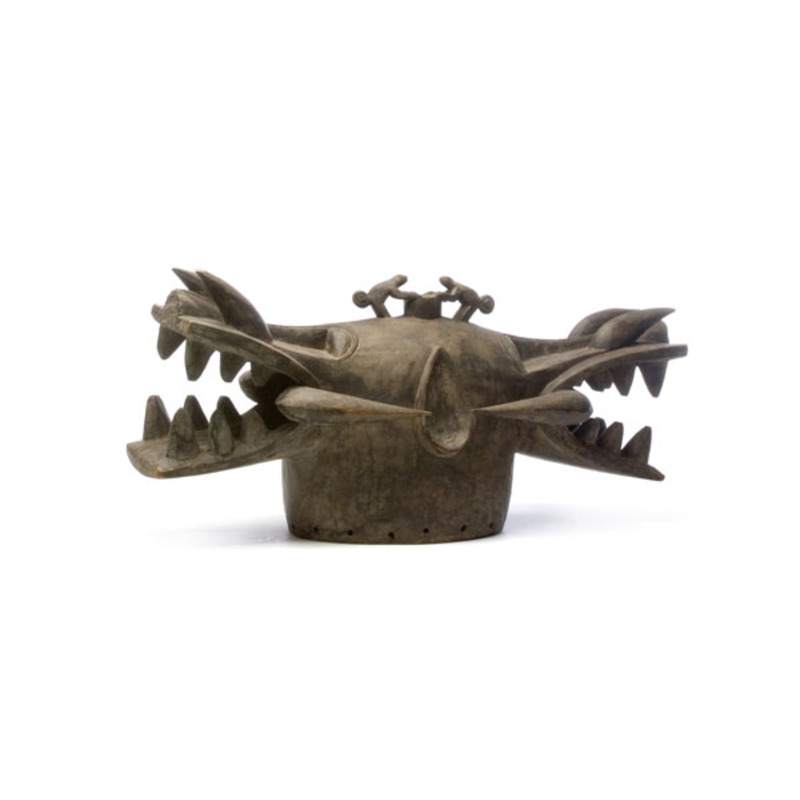ca 1845, marked on all four posts H.BOYD CINI OHIO, in walnut. With simply turned posts, a scrolled, curly walnut headboard, and a fine, old, dry surface; posts are 78" high, rails are 73.75" long, and the headboard is 51" wide. Henry Boyd (1802-1886) was born a slave in Kentucky. He apprenticed to a cabinetmaker and was able to purchase his freedom in 1820. Six years later he removed to Cincinnati and worked in an iron factory and as a carpenter. By 1836, he had opened his own factory where he produced bedsteads. He developed an innovative construction, which he called the "wood screw and swelled rail" bedstead that allowed the bed to remain tightly assembled without the use of iron bolts. He advertised his bed in the Cincinnati Daily Gazette in 1839. Although it was his invention, Boyd was, legally, unable to patent it since he was an African American. In 1833, the design was patented by cabinetmaker George Porter (U.S. Patent Office N. 7911X). It is not known if Boyd had enlisted Porter's help in patenting the bedstead but it seems probable. That same year, Porter advertised that he had recently patented a bedstead of his own, one that used an "iron fastening". Sadly, Boyd's effort to patent his bed was not the only time his business was hindered because of racial discrimination--his factory was burned out three times during his career. Despite this, however, Boyd prospered and his bedsteads proved so popular that imitations soon appeared on the market. When James Tompkins attempted to sell such a bed in 1842, Boyd began stamping his beds, clearly marking them as authentic. In the June 27, 1843 issue of the Daily Gazette, Boyd even printed a list of customers, one that include some very prominent Cincinnatians, who would recommend his beds. In that same ad, Boyd also warned Caution: There are imitations of this Bedstead in market very much resembling it. The genuine, which only he warrants, are all stamped "H. Boyd." Charles Cist, in 1841, wrote, I was one of [Boyd's] first customers, and found those of his make so much better than what I already had, that I sent these last off to auction and replaced them with others from Boyd's factory. See Sikes, The Furniture Makers of Cincinnati 1790 to 1849 and Columbus Museum of Art, Made in Ohio: Furniture 1788-1888. Condition: Replaced side rails (converted), several small repairs, lacking tester.
ca 1845, marked on all four posts H.BOYD CINI OHIO, in walnut. With simply turned posts, a scrolled, curly walnut headboard, and a fine, old, dry surface; posts are 78" high, rails are 73.75" long, and the headboard is 51" wide. Henry Boyd (1802-1886) was born a slave in Kentucky. He apprenticed to a cabinetmaker and was able to purchase his freedom in 1820. Six years later he removed to Cincinnati and worked in an iron factory and as a carpenter. By 1836, he had opened his own factory where he produced bedsteads. He developed an innovative construction, which he called the "wood screw and swelled rail" bedstead that allowed the bed to remain tightly assembled without the use of iron bolts. He advertised his bed in the Cincinnati Daily Gazette in 1839. Although it was his invention, Boyd was, legally, unable to patent it since he was an African American. In 1833, the design was patented by cabinetmaker George Porter (U.S. Patent Office N. 7911X). It is not known if Boyd had enlisted Porter's help in patenting the bedstead but it seems probable. That same year, Porter advertised that he had recently patented a bedstead of his own, one that used an "iron fastening". Sadly, Boyd's effort to patent his bed was not the only time his business was hindered because of racial discrimination--his factory was burned out three times during his career. Despite this, however, Boyd prospered and his bedsteads proved so popular that imitations soon appeared on the market. When James Tompkins attempted to sell such a bed in 1842, Boyd began stamping his beds, clearly marking them as authentic. In the June 27, 1843 issue of the Daily Gazette, Boyd even printed a list of customers, one that include some very prominent Cincinnatians, who would recommend his beds. In that same ad, Boyd also warned Caution: There are imitations of this Bedstead in market very much resembling it. The genuine, which only he warrants, are all stamped "H. Boyd." Charles Cist, in 1841, wrote, I was one of [Boyd's] first customers, and found those of his make so much better than what I already had, that I sent these last off to auction and replaced them with others from Boyd's factory. See Sikes, The Furniture Makers of Cincinnati 1790 to 1849 and Columbus Museum of Art, Made in Ohio: Furniture 1788-1888. Condition: Replaced side rails (converted), several small repairs, lacking tester.















Testen Sie LotSearch und seine Premium-Features 7 Tage - ohne Kosten!
Lassen Sie sich automatisch über neue Objekte in kommenden Auktionen benachrichtigen.
Suchauftrag anlegen